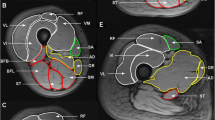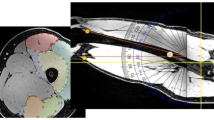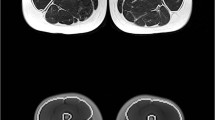Abstract
Quantitative data on muscle volume (MV) are important for estimating maximal muscle power. The objective of this study was to determine the correlation between anatomical cross-sectional areas (ACSAs) and the MV in thigh muscles (extensors, flexors, adductors, and sartorius) in perimenopausal women, and to identify at which proximal-to-distal level a single-slice ACSA measurement with magnetic resonance imaging (MRI) displays the highest correlation in each of these. Axial MRIs of the thigh were acquired in 41 perimenopausal women aged 50.8 ± 3.2 years. Segmentation of the extensors, flexors, adductors, and the sartorius was performed between the femoral neck (0%) and the distal end of the intermediate vastus (100%). MVs were determined by numerical integration, and the ACSA was calculated from three-dimensional reconstructions at 10% intervals from proximal to distal. The extensors contributed 50%, the flexors 19%, the adductors 28%, and the sartorius 3% of the total thigh MV. Maximal correlations between ACSA and MV were observed at the 20–40% proximal-to-distal level in the extensors (R 2 = 0.73), at 30% in the adductors (R 2 = 0.82), and at 70% in the flexors (R 2 = 0.72) and sartorius (R 2 = 0.85), respectively. ACSA at 50% displayed the highest overall correlations (R 2 ≥ 0.69) with MV for all muscle groups. Single-slice ACSAs from MRI displayed high correlations with MVs. Although the (proximal to distal) measurement locations with the highest correlation varied between the muscle groups, a single slice at the 50% location achieved the best compromise in terms of correlation between ACSA and MV across extensors, flexors, adductors and the sartorius.




Similar content being viewed by others
References
Abe T, Brechue WF, Fujita S, Brown JB (1998) Gender differences in FFM accumulation and architectural characteristics of muscle. Med Sci Sports Exerc 30:1066–1070
Abe T, Kumagai K, Brechue WF (2000) Fascicle length of leg muscles is greater in sprinters than distance runners. Med Sci Sports Exerc 32:1125–1129
Akagi R, Takai Y, Ohta M, Kanehisa H, Kawakami Y, Fukunaga T (2009) Muscle volume compared to cross-sectional area is more appropriate for evaluating muscle strength in young and elderly individuals. Age Ageing 38(5):564–569
Berg HE, Tedner B, Tesch PA (1993) Changes in lower limb muscle cross-sectional area and tissue fluid volume after transition from standing to supine. Acta Physiol Scand 148:379–385
Blazevich AJ, Coleman DR, Horne S, Cannavan D (2009) Anatomical predictors of maximum isometric and concentric knee extensor moment. Eur J Appl Physiol 105:869–878
De Ste CM, Deighan M, Armstrong N (2003) Assessment and interpretation of isokinetic muscle strength during growth and maturation. Sports Med 33:727–743
Doherty TJ (2003) Invited review: aging and sarcopenia. J Appl Physiol 95:1717–1727
Fukunaga T, Roy RR, Shellock FG, Hodgson JA, Edgerton VR (1996) Specific tension of human plantar flexors and dorsiflexors. J Appl Physiol 80:158–165
Fukunaga T, Miyatani M, Tachi M, Kouzaki M, Kawakami Y, Kanehisa H (2001) Muscle volume is a major determinant of joint torque in humans. Acta Physiol Scand 172:249–255
Kanehisa H, Ikegawa S, Tsunoda N, Fukunaga T (1994) Strength and cross-sectional area of knee extensor muscles in children. Eur J Appl Physiol Occup Physiol 68:402–405
Kawakami Y, Abe T, Fukunaga T (1993) Muscle-fiber pennation angles are greater in hypertrophied than in normal muscles. J Appl Physiol 74:2740–2744
Kawakami Y, Abe T, Kuno SY, Fukunaga T (1995) Training-induced changes in muscle architecture and specific tension. Eur J Appl Physiol Occup Physiol 72:37–43
Kubo K, Kanehisa H, Azuma K, Ishizu M, Kuno SY, Okada M, Fukunaga T (2003) Muscle architectural characteristics in young and elderly men and women. Int J Sports Med 24:125–130
Macaluso A, De Vito G (2004) Muscle strength, power and adaptations to resistance training in older people. Eur J Appl Physiol 91:450–472
Maganaris CN, Baltzopoulos V, Tsaopoulos D (2006) Muscle fibre length-to-moment arm ratios in the human lower limb determined in vivo. J Biomech 39:1663–1668
Morse CI, Degens H, Jones DA (2007) The validity of estimating quadriceps volume from single MRI cross-sections in young men. Eur J Appl Physiol 100:267–274
Narici MV, Roi GS, Landoni L, Minetti AE, Cerretelli P (1989) Changes in force, cross-sectional area and neural activation during strength training and detraining of the human quadriceps. Eur J Appl Physiol Occup Physiol 59:310–319
Narici MV, Landoni L, Minetti AE (1992) Assessment of human knee extensor muscles stress from in vivo physiological cross-sectional area and strength measurements. Eur J Appl Physiol Occup Physiol 65:438–444
Narici MV, Maffulli N, Maganaris CN (2008) Ageing of human muscles and tendons. Disabil Rehabil 30:1548–1554
Raj IS, Bird SR, Shield AJ (2010) Aging and the force-velocity relationship of muscles. Exp Gerontol 45:81–90
Ring-Dimitriou S, Steinbacher P, von Duvillard SP, Kaessmann H, Muller E, Sanger AM (2009) Exercise modality and physical fitness in perimenopausal women. Eur J Appl Physiol 105:739–747
Acknowledgments
We would like to thank the Paracelsus Medical University Forschungsfond for supporting this study and the participants who volunteered to take part in this MRI study.
Author information
Authors and Affiliations
Corresponding author
Additional information
Communicated by Arnold de Haan.
Rights and permissions
About this article
Cite this article
Cotofana, S., Hudelmaier, M., Wirth, W. et al. Correlation between single-slice muscle anatomical cross-sectional area and muscle volume in thigh extensors, flexors and adductors of perimenopausal women. Eur J Appl Physiol 110, 91–97 (2010). https://doi.org/10.1007/s00421-010-1477-8
Accepted:
Published:
Issue Date:
DOI: https://doi.org/10.1007/s00421-010-1477-8




